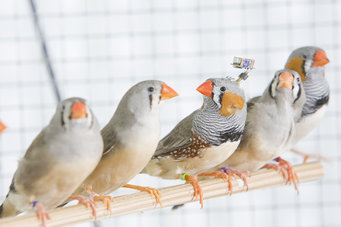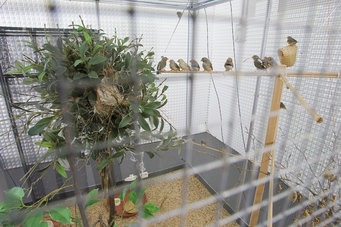The singing of zebra finches
Manfred Gahr and his team want to find out what goes on in the heads of zebra finches when the males and females engage in a tête-à-tête.
Text: Marcus Anhäuser

Just three more boxes. Manfred Gahr apologizes for the slight disarray. “Just these three and the move is complete,” he says. When they are unpacked, his office – the room in which renowned behavioural physiologist Erich von Holst once lived and worked – will be fully set up and ready for work. The fireplace by the door originates from von Holst’s time, but there is little else that recalls this great era of classical behavioral biology. For the Max Planck Institute for Ornithology in Seewiesen, southwest of Munich, a period of radical change has come to an end.
The institute, formerly known as the Max Planck Institute for Behavioral Physiology and located in a forest between Lakes Starnberg and Ammer, has just emerged from four years of reorganization and renovation. It is steeped in history: many famous behavioral scientists have researched here, the most prominent being Konrad Lorenz. Since his appointment, Gahr, together with fellow Director Bart Kempenaers, has mainly been occupied with the planning and restructuring of the entire institute complex and the simultaneous establishment of a new research department. “Apart from the outer walls, hardly a single stone remains in place,” he says. A fitting celebration in honor of its completion is being planned for next summer.
In the meantime, the 50-year-old scientist, who was born in the Palatinate region of Germany, can once again concentrate on his actual research objective: unlocking the secret of birdsong. With the help of a wide array of methods from the fields of electrophysiology, molecular biology and behavioral biology, Gahr and his team aim to find out what goes on in a bird’s head when it sings or hears the chirping of its conspecifics. Birds do not sing for the fun of it. Behind this activity lie very concrete interests: male birds learn their song to impress females and to enhance their reproductive prospects.
The secret of birdsong
The researchers in Seewiesen not only focus on the neuroanatomy of the typical areas of the songbird brain, such as the song nuclei, which are located in the forebrain (and include the nucleus robustus arcopallii, or RA for short), but even examine individual neurons at work when a male bewitches a female with his song or a young bird learns the basics of social chirping. They also study how both genes and learning behavior influence a bird’s typical song and calls. “We record the activity in the brain so that we can link the molecular mechanisms at the cellular level with the animal’s behavior,” says Gahr.

To do this, the research group headed by his colleague Andries ter Maat uses methods that involve the comprehensive and extensive use of observation technology that would make any secret service proud. Gahr has known ter Maat, an experienced electrophysiologist, since his time at the University of Amsterdam. For the purpose of this research, the Dutchman with the long silver hair launched what can only be described as large-scale wire(less)tapping of the department’s zebra finches: he and his colleagues combine the listening of the calls and songs of the small finches with the telemetric recording of their brain waves. Along with video recordings, the acoustic and neuronal recordings are made on an almost continuous basis – total surveillance, so to speak. Gahr’s team developed most of the technology needed for this operation themselves. The decision to focus on zebra finches, which weigh only ten grams, was no coincidence: the zebra finch is the avian species most commonly kept in laboratories all over the world.
“They have a few disadvantages, but these are clearly outweighed by their advantages,” says Gahr, who has already worked with other songbirds, chickens and various reptile species in the course of his career. The crucial factor is that, “Because they are colony breeders, we can breed them successfully under good conditions in the laboratory,” explains the neurobiologist. The little chirpers feel safe and well only in the company of other birds. The researchers can thus keep a large number of the birds in a relatively small space. The department has between 800 and 900 zebra finches, and the total kept by the institute is probably around 2,000.
The zebra finch – an advantageous avian model
The zebra finches are kept, for example, in House 6b, an elongated building clad with natural timber panels. It is one of the few new buildings on the grounds of the institute, and also its centerpiece. The building can be accessed without getting rained on through a roofed passageway leading from the department’s office building. A centrally located “bistro corner” on the first floor provides the perfect place for a coffee break. The finches live on the ground floor, which contains row upon row of aviaries. The two-and-a-half-meter-high wire cages are fitted with a few perches and scattered with dry twigs.

When someone enters the aviary room, a few of the small balls of feathers flutter nervously to and fro. Others sit huddled close together on the perches. The room is filled with typical chirping sounds that always sound like a rubber duck with a very low squeak. From time to time, complex sequences of notes with repeated syllables can be heard. However, compared with the virtuoso singing of the male blackbird or the European stonechat, the sounds produced are not particularly impressive. “But that is an advantage of the zebra finch,” says Gahr. “Its song is easy to decipher.” It consists of just eight to ten individual elements that are nevertheless sufficiently complex. “Animals with more layered songs pose problems for us when it comes to quantification,” says Gahr.
Moreover, the female zebra finches do not sing, which makes them ideal for comparative research. Another advantage of the species is that the mature male does not learn any new song elements. They have thus learned everything there is to know by a certain age. This enables the researchers to establish what a bird learns, and how and when it learned it. “However, this is also one of the disadvantages of this species,” says Gahr. Hormone-sensitive song changes and learning processes in adulthood cannot be studied using this bird model. For this reason, the Max Planck researchers also work with another species, the canary, which is known for its ability to learn new songs throughout its lifecycle.

Andries ter Maats’s observation methods are not identifiable at first glance. In the corner of another room stands an aviary measuring two square meters in area and two meters high. Two plastic trees stand in the middle of the wood-chip strewn floor, and the cage is fitted with perches. “This is our semi-natural habitat,” says ter Maat, who speaks with a slight Dutch accent. “It could also be described as a semiartificial habitat,” he adds with an ironic grin. The aviary is shielded by two sound-absorbing walls that also provide visual cover. Two stainless steel antennae protrude into the aviary space. The finches live a relatively undisturbed life in this aviary and under controlled environmental conditions – their nutrition is calibrated to the gram and the number of “roommates” is precisely defined.
Innovation: mobile recordings of neuronal activity
Two short, thin metal pins, partly covered by the feathers, protrude from the heads of some of the finches. These provide a direct connection to the world inside the birds’ brains. Such an electrode is familiar to anyone who makes electrophysiological recordings of animals, but the one used here is different. “Our recording process is mobile,” explains Manfred Gahr. The pin is usually connected to a cable that transmits the neuronal signals emitted by individual or entire groups of neurons from the brain to a computer.

But cables would not be very useful in an environment like this one, with its perches and artificial trees. “Mobile recording is the only option if we want to study the animals behaving normally under largely natural conditions,” says Gahr. The introduction of a second cabled-up animal to the mix would inevitably result in a jumble of cables. Thus, instead of a cable, the researchers attach to the metal pins a radio transmitter weighing just one gram. This transmits the neuronal activity data to the stainless steel antennae, from which they are forwarded to the computer via the receiver.
Alternatively, the researchers could attach a mobile minicomputer, a data logger, to the birds’ backs. However, in view of the volumes of data produced by the recorded brain area, the mobile memory would quickly become full. “To resolve the neuronal signals, we have to use a very high sampling rate, and that produces enormous volumes of data for just one animal,” says Gahr. The sampling rate is 20 kilohertz. This produces 22 kilobytes of data per second, which is just under 80 megabytes per hour and 800 megabytes over the course of a ten-hour day. Typically, data from up to eight animals is recorded simultaneously, which quickly results in several gigabytes of data every day.
Wanted: small and light energy storage

The transmission of the data by telemetry is not the problem either. “The crux is the system’s energy supply,” explains the Max Planck Director. As with all mobile devices, whether laptops, cell phones or digital cameras, the technical limits are dictated by battery size. In the case of the bird transmitter, the researchers availed themselves of the smallest commercially available energy storage device they were able to find: a hearing-aid battery. This is the only way they can keep the weight down to around one tenth of the zebra finches’ body weight. The battery provides enough power for five days of constant operation, which is sufficient to produce initial results.
But such telemetric devices cannot simply be purchased at the local electronics store. The transmitter was, in fact, developed by the scientists themselves. “Scientists have been building mobile devices for electrophysiological recordings in animals for around 30 years now,” explains Gahr. He had already tinkered with just such a system in the 1990s when he worked as the head of a junior research group at the old MPI for Behavioral Psychology in Seewiesen. “But that was more of a sideline.”
Today, he affords himself the luxury of the services of two electronics engineers who focus exclusively on this task. They regularly trawl the market for the latest developments. And their efforts pay off: they will soon complete the development from the analog to the digital age in mobile recording – and thus attain a crucial advantage: Analog technology allows the scientists to record only one location per animal, while the digital equivalent will enable the simultaneous recording of neurons in several locations of the avian brain. Nevertheless, the behavioral physiologists are very pleased with what they have already achieved without the digital technology. “Our current system is a masterpiece of miniaturization,” reports Andries ter Maat with pride. It consists of a measurement amplifier, the transmission unit and the battery. Wrapped in a silicon cover, the entire device weighs just over 1 gram and has a range of 20 meters.
The researchers’ biggest worry is that the device may hinder the animals in their behavior. However, a test showed that, just one to two days after the implantation procedure, the finches behave exactly as before. “The behavioral limitations are mainly caused by the effect of the anesthetic,” says ter Maat. The same reactions would arise if an animal were anesthetized without having a transmitter implanted. The operation is comparable to the fitting of a dental implant and takes around one and a half hours to carry out on the anesthetized bird.

According to Gahr, the time-consuming element of the operation is the precise placement of the electrode in the RA, the neuronal zone involved in the control of birdsong. The operator inserts the electrode, which is just a few hundredths of a millimeter thick, into the brain area until a signal is obtained from the nerve cells. He then locks it in place using a synthetic polymer that dentists also use, and superimposes a pin with the transmitter attached to it. Thanks to the dental adhesive, the electrode sits securely in the skull and can even withstand the hectic activity of the finches.
With their mobile recording device, the Max Planck researchers have the kind of tool at their disposal that the members of their profession have long dreamed of. This device finally makes it possible to examine an animal as small as a ten-gram zebra finch or a mouse while it engages in entirely normal social behavior. It could also be used to study bigger birds. Manfred Gahr has crows in mind here, for instance, which, like zebra finches, are also songbirds but much larger in size. Far bigger batteries could be used on such birds, perhaps enabling the scientists to obtain recordings over several weeks under completely natural living conditions. A doctoral student and an undergraduate are currently studying the sexual and social lives of crows and the associated typical repertoire of sounds produced by the birds in their natural environment.
Recording data around the clock
Here in the environment of the aviaries, the researchers combine electrophysiological recordings with sound recordings of the calls and songs of individual male and female zebra finches to study the links between acoustic stimuli and neuronal processing. In addition to the mobile recording system, the researchers also use mobile microphone transmitters for this element of their research. The birds being used for this purpose can be identified within the group of zebra finches by the longish antennae running parallel to their backs. This system is another masterpiece of miniaturization and weighs just 1.4 grams.
Ter Maats’s research group uses the mobile devices to make continuous data recordings not only in the aviary, but also in so-called sound boxes. These cozy, soundproof boxes, which are one meter wide and fitted with glass doors, are shared by a male and a female zebra finch for a specific period of time. The song of both birds is recorded using the same non-stop procedure as the neuronal activity of one of the two birds. All of the data is collated in separate rooms on servers. In so doing, Gahr’s researchers generate mountains of information: between 40 and 50 gigabytes of neuronal and acoustic data per day. This means that they produce between 15 and 20 terabytes of data in one year. The data is evaluated using software developed by the scientists themselves. Without this software, the volumes of data produced would be completely unmanageable.
The scientists’ skill and ingenuity lies in their ability to identify patterns and find answers to their research questions within this mountain of data. One of the key questions they would like to clarify concerns the precise activity patterns of song neurons in the socio-sexual context. Up to now, it has not really been possible to answer this question, and this is the very area in which the researchers in Seewiesen have made some very exciting discoveries.
Andries ter Maat sits in his office and points to a graph with two curves: “Above you see the recording from a neuron in the song nucleus of the male, and below it, the acoustic curve of a female making what is known as a ‘tet’ call.” The tet call is one of the most common calls of the zebra finch and is made up to 10,000 times a day. At the beginning, the neuronal signal displays an activity akin to background noise. However, before the female makes its tet call, the activity of the neuron in the male brain declines. When the call has ended, the activity of the neuron surges to a maximum value and then returns to the same level as before the female’s call.

“That’s fascinating,” says ter Maat, “because the male’s song neuron is inhibited.” This shows that the neuron that actually controls motor function reacts in the presence of the female, like a sensory cell to its call. This finding is very exciting but, as is so often the case in research, it immediately raises a lot of other questions. Why does the blockade begin shortly before the female makes the call? Do the male’s song neurons also react to the visually perceived behavior of the female?
In his seminal work on the zebra finch, Richard Zann, the Australian pioneer of field research on zebra finches, who died in a bush fire in early 2008, had the following to say about tet calls: “(…) they are not directed at specific individuals and do not stimulate specific replies.” According to Zann, tet calls form a kind of soft background hum in which other calls are embedded. However, the data produced by ter Maat’s research group suggest otherwise.
The recordings reveal a clear connection between the tet calls of female and male finches. The tet calls also highlight the particular advantage of the telemetry microphones. The female’s call occurs exactly between two male tet calls. This happens so often and with such precision that it cannot be a coincidence. “The females and males listen carefully to their partners,” says ter Maat. Such results point the electrophysiologist in a completely different direction: “What we would ultimately like to know, of course, is what all of these tet calls, stack calls, and the entire to-ing and fro-ing mean. This takes us to the field of language,” says the Dutchman. However, before the researchers can go there, a few gigabytes of data remain to be evaluated.
What else they will discover with their telemetric methods is basically a matter for the researchers and their imaginations. No other laboratory in the world can carry out mobile electrophysiological recordings of animals in their normal social environment. Manfred Gahr and his colleagues have a lot more work planned with their tiny recording devices. And now that the renovation of the institute in Seewiesen has elevated it to a new splendor, the Max Planck Director finally has the time to focus on his research. And those last three boxes will soon be unpacked.
Glossary
Song nuclei
Regions in the avian brain involved in the learning and production of song. The HVC and RA song nuclei in adult male zebra finches are several times larger than the corresponding areas in the adult female brain.
Habitat
An organism’s living space.
Sampling rate
Sampling is the recording of measurement values at discrete points in time, usually at regular intervals. The number of samples recorded per second is known as the sampling rate.
Inhibition
Due to a certain impulse, a nerve cell is not stimulated to form an action potential and the signal transmitted by this neuron is attenuated as a result.



















